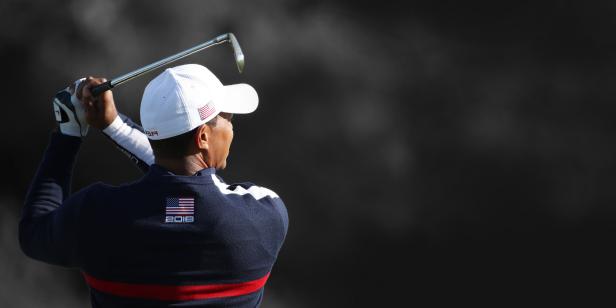The Ryder Cup began in 1927, but it didn’t really get cooking until 1983. Before then, the Americans dominated to an absurd degree, losing only three times in 24 Cups. But in ’83, Tony Jacklin took over as the European captain, Seve Ballesteros entered the legendary phase of his career, and everything changed. Since then, it’s been a rugged battle between two great teams that has blown up into one of the premiere events in sport, and there’s no better way to analyze the tug and pull of those battles than to take a deep, illuminating dive into the statistics since ’83. In the interactive you see below, we explore everything that’s interesting, from team records in different formats to the performance of captain’s picks and rookies to how each position in the final standings fared in the actual event. These are fascinating numbers whether you’re a casual fan or a Ryder Cup obsessive, and before today, they’ve never been compiled outside the war rooms of the Ryder Cup captains and their statistical gurus.
Here are the ten biggest takeaways from the information above:
1. It should come as no surprise that the home team enjoys an advantage in each of the three formats, but it is surprising that while Fourball and Singles hover around 52% for the home team, Foursomes (aka “alternate shot”) is higher to a statistically significant degree, with more than 56% of all matches going to the home team. The last two Ryder Cups showed a great example of this phenomenon; in Paris, the Europeans went 6-2 in Foursomes, while at Whistling Straits, the Americans returned the favor with the exact same record.
2. If you wanted evidence that the Europeans have been strategically sharper than the Americans since ’83, look no further than the records by format. In the pairs sessions, the Europeans have thrived, winning 55% of all Fourball matches and 52.6% of all Foursomes matches. In singles, though, it’s the Americans who came out on top with a narrow edge of 51.1%. The obvious conclusion here is that America’s talent surplus comes to the fore in singles, but in the formats where tactical maneuvering yield the most benefit, Europe has excelled.
3. Captain’s picks have only been moderately successful. Combined, both the U.S. and European captain’s picks have won at about a 50% clip, with Europe just slightly more successful. We all know stories of great successes and failures, like how the American Ryder Cup captain’s picks dominated at Whistling Straits while Jim Furyk’s picks in Paris were steamrolled, but over time, this all appears to balance out. This is especially interesting in the context of both teams adding more and more captain’s picks each year.
4. Ian Poulter is the ultimate captain’s pick, having been selected a record five times. In those Ryder Cups, his record is 11-6-2. Seems like a pretty good choice! Current U.S. vice captain Stewart Cink is the only American to have been selected three times, and finished those Ryder Cups with a 3-3-7 mark.
5. As far as rookies go, this might be the most surprising statistic of all. The American rookies have compiled a very respectable record of 113-104-40, almost a full ten matches above .500, while the Europeans are an abysmal 78-101-37. That’s a shocking total from the team that has been overall much better than the Americans since ’83.
6. Justin Thomas, selected as a captain’s pick this year, is the only American to ever compile four wins in his rookie campaign, accomplishing that feat on the road in Paris in 2018. (Collin Morikawa nearly tied him at Whistling Straits, but had to settle for a half in singles against Viktor Hovland.) Thomas Pieters bagged four wins for Europe at Hazeltine in 2016, and Tommy Fleetwood duplicated his feat in Paris with four wins courtesy of the famous “Moliwood” pairing.
7. And how about the winning percentage by the Ryder Cup standings? Here, we see how mightily the U.S. has struggled at the top of the table. The player who finished first in the standings since ’83 has a winning rate of just 45.9%, while number two is even worse at 37.7%. Nowhere was this difficulty more evident than 2004, when Tiger Woods and Phil Mickelson came in 1-2 and proceeded to combine for a 3-6 record as Europe ran up an historic victory. This also gives evidence for something Europe has prided themselves on for decades: They’re giant killers at the Ryder Cup.
8. Europe, meanwhile, has excelled at the top, with a 61.2% rate for its top seed, 56.3% for no. 2, and 56.2% for no. 3. It’s long been a stereotype of Ryder Cup golf that Europeans are better at putting their egos aside, even at the upper echelons of the game, and playing for the good of the team, and this might be the best evidence we have for that talking point.
9. The Americans are actually better the lower you go in the pecking order, with the highest percentages at no. 6 in the standings (54.6%) and no. 8 (53.6%). It gives some food for thought—maybe it’s not so great to use six captain’s picks!
10. Europe’s winning percentages tend to drift downward the lower you go in the standings, falling to 39.7% by position 8, with one major exception—the no. 7 players are winning at a 61.2% clip. In general though, the higher American numbers near the bottom give credence to the idea that the U.S. usually has far more depth, while the Europeans come to the Ryder Cup with top-heavy teams.
